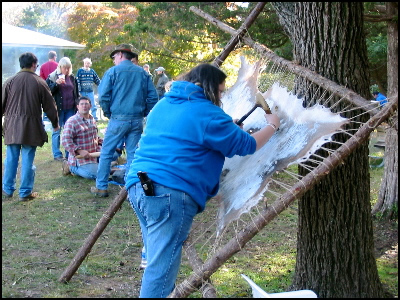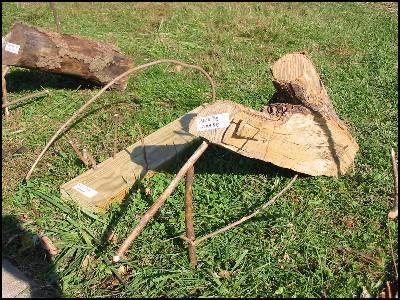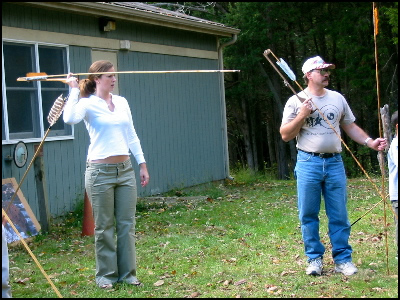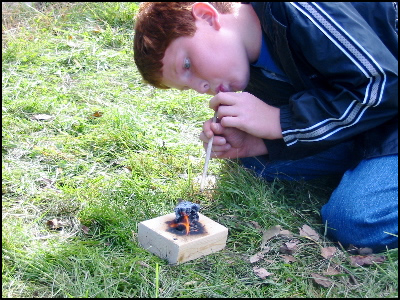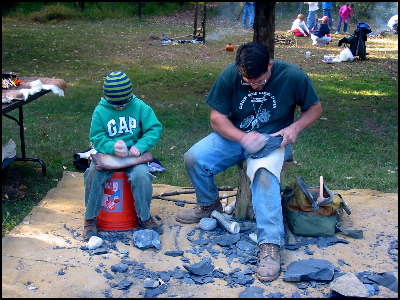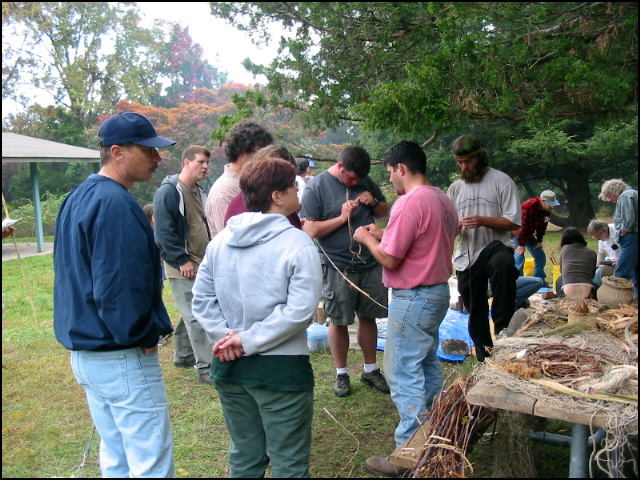Autumn was a unique and special time of the year in the
lives of the aboriginal peoples that inhabited the Delaware Valley
for centuries prior to European contact and settlement
in the 1600s. Known collectively as the Lenape-
Delaware, these Woodland people lived in small
bands or villages in the vicinity of what is now
Washington Crossing State Park and throughout
New Jersey, eastern Pennsylvania, southern
New York and northern Delaware.
By the end of summer, the seasonal
fish that had traveled up the Delaware River
and the many rivers, tributary  streams and
lakes were now migrating back to the sea.
Spring and summer had been a good time
for fishing and hunting marsh birds,
passenger pigeons, and other seasonal
game, including frogs and turtles. With
the arrival of autumn, edible plants,
new roots, berries, nuts and other foods
growing abundantly throughout the warm
days of late spring and summer would
be gathered. Deer, elk, bear, and raccoon
may not have been hunted intensively
during the spring and summer, due to their
thin fur and their flesh being lean. Now
with autumn upon them, the animal’s fur
began to thicken, and they were fattening up
on the variety of plants abundantly available
to them during the fall season, preparing them
for the coming winter. As hunters and gatherers,
the Indian people had to rely on nature for all their
food. During the early fall, the people continued to
fish, as they did through the spring and summer, along riverbanks
and shorelines. In the autumn, adult eels would migrate from the many rivers to the sea to spawn, and the Indians would catch
thousands of these in the Delaware in a single night, using a kind
of basket weir or “eel pot.” These traps were constructed with a
funnel-like insert at the aperture, which was set to face upstream.
The captured eels were skinned and the surplus meat was dried
and stored for future use.
streams and
lakes were now migrating back to the sea.
Spring and summer had been a good time
for fishing and hunting marsh birds,
passenger pigeons, and other seasonal
game, including frogs and turtles. With
the arrival of autumn, edible plants,
new roots, berries, nuts and other foods
growing abundantly throughout the warm
days of late spring and summer would
be gathered. Deer, elk, bear, and raccoon
may not have been hunted intensively
during the spring and summer, due to their
thin fur and their flesh being lean. Now
with autumn upon them, the animal’s fur
began to thicken, and they were fattening up
on the variety of plants abundantly available
to them during the fall season, preparing them
for the coming winter. As hunters and gatherers,
the Indian people had to rely on nature for all their
food. During the early fall, the people continued to
fish, as they did through the spring and summer, along riverbanks
and shorelines. In the autumn, adult eels would migrate from the many rivers to the sea to spawn, and the Indians would catch
thousands of these in the Delaware in a single night, using a kind
of basket weir or “eel pot.” These traps were constructed with a
funnel-like insert at the aperture, which was set to face upstream.
The captured eels were skinned and the surplus meat was dried
and stored for future use.
The Lenape knew well the proper time for planting and
harvesting. They had no written calendar but the moon and stars
guided them in this. The Pleiades, a bright cluster of stars that
were most visible in the wintertime, were particularly related to
planting. As the Pleiades began to set in the western sky about
the beginning of May, it was time to prepare the soil and plant the
seeds. In October, when this star cluster reemerged,
the time was right for harvesting the crops. Many
garden vegetables were eaten day by day as they
ripened, but others were stored for use in the
fall and winter. Drying could preserve almost
every type of food such as meat, fish, shellfish,
nuts, berries, mushrooms, roots, and
tubers. Indian women preserved some of the
corn they grew by peeling back the husks, braiding the ears, and hanging the clusters from the house poles and roof supports of
their bark shelters.
The Indians employed various types
of storage facilities. Foods used daily
were kept in woven baskets, skin pouches,
gourds, or broken clay pots that had been
subsequently mended. These could be
conveniently stored on shelves or under
sleeping platforms in the dwellings. The
remainder would be held in simple granaries
attached to their houses or in storage
pits dug into the earth, located inside and
outside the wigwams.
With the first harvest came the “Green
Corn Ceremony,” a major annual celebration
that probably formed the basis of what was
to become the “Big House Ceremony “that the
Lenape-Delaware Indians have celebrated in more
recent times. One form or another of the ceremony was
practiced by most of the horticultural Indians of eastern
North America from New England to the Gulf of Mexico. During
the Green Corn Ceremony, which could last as long as twelvedays, the Lenapes thanked the Corn Woman, for the crops she had
given them. This spirit was sometimes thought of as the first human
being. Her existence demonstrated the depth of the Lenape
identification of women with horticulture. “Mother Corn” had
dominion over all vegetation of the plant world, and is envisioned
as an elderly woman who resided in the far heavens.
The harvest would have been brought in and dried in
October, and the Indian’s base camps by this time of year, would
be well supplied with stored food. By late fall, Lenape Indian
family bands, made up of men, women, and older children got
themselves ready for the autumn hunt and dispersed into the
forest to hunt and gather nuts. The people would reside on and
off during the winter months at these interior hunting territories
and nut harvesting camps. Nuts of many kinds such as hickory,
acorns, walnuts and butternuts were now in abundant supply;
and fat, thick-pelted deer, elk, bear, raccoons, and turkeys were
available. The meat and pelts of these animals would be greatly
needed to survive in the coming winter and early spring season.
Hunting territories could measure up to 200 square miles
in area, but others considerably smaller, were bounded by natural
landmarks such as streams, rock outcroppings, hills, lake shores,
or sea coasts. Traditional rights to such game areas were recognized
and respected. Many interior and mountain regions were
sparsely populated, or sometimes completely uninhabited except
during the hunting and nut-gathering seasons.
An early observer of the Indians, Peter Lindestrom,
indicated that the Indians would sometimes burn the woods and
thickets to make tracking and hunting of deer easier, and used
fire-surrounds to encircle and trap wild game. Burning also
opened clearings and allowed a more abundant growth of grass
and shrubs. These practices manipulated the natural forest habitat
and promoted succulent vegetation and other conditions that
greatly favored deer and elk populations.
These hunting and gathering bands periodically returned
home to their permanent villages during December with the flesh
of the animals they had not been able to eat while fresh, smoking
and drying the food enroute. The returning family bands brought
back fresh venison, animal skins, firewood, and bone grease. The
Lenape Raritan bands are thought to have spent their winters “in
the sheltered valleys at the foot of the Watchung Mountains.”
The Lenape Indian family bands living in the area of present day
Washington Crossing likely had their hunting and nut-gathering
territories throughout the Sourland Mountain region.
The Native Americans hunted no more than they needed
to survive, in order to preserve the balance of nature. Such conservation in hunting was an integral part of their spiritual
beliefs. Animals were believed to be intelligent, conscious fellow
members of the same spirit world as the Indians, and therefore
would be treated with dignity and respect. In the spirit world, the
very existence of the Indian was linked with that of the animals,
and both the human hunters and the game animals understood the
role each must play to enable the Indian to survive.
Autumn - The Big House Ceremony
The Lenape were a very religious people. Like many
other prehistoric-tribal peoples, they believed in a world filled
with supernatural spirits. All things were thought to be alive and
animated by spirit forces or the manëtuwàk. The manëtuwàk and
all other beings were created by Kishëlemukòng or, the “Creator”.
Kishëlemukòng literally means “He who creates us by his
thoughts” in the Delaware language The Lenape-Delawares believed
that this Creator was the single, all powerful supernatural
power, and was known to most Native Americans as the “Great
Spirit.”
The “Mësingw” (literally meaning “Living Solid
Face”) was the “manëtu” or spirit being, of singular importance
to the well being of every Lenape person. Also known as the“Masked Being” or “Keeper of the Game” it was this spirit’s
responsibility to look after the animals in the forest and he kept
a benevolent eye on all creatures. Mësingw surveyed his vast
domain from the back of a large buck and it was believed that
he could be seen from time to time riding through the forest,
herding deer. Mësingw was a strange looking spirit, with a large
round face, the right side colored red and the left black; his body
was covered from head to foot with long black hair similar to
that of a bear. Although usually benevolent, he could be angry
and resentful if not properly revered and feasted. If a hunter did
not show the right respect to the Mesingw, the animals of the
forest might not appear or present themselves to the hunter. Because
Lenape hunters had to pursue deer and other game in his
domain, and women and children needed to collect nuts, plants,
and firewood in the forest, it was especially important that all
the Indians be on good terms with the Mësingw. If he was unhappy,
he could ruin a person’s hunting and gathering fortunes.
The Big House Ceremony was one of the most important
annual events in the religious lives of the Lenape Indians
who had migrated from New Jersey to Oklahoma and Canada
during the historic period. The Big House Ceremony was no
doubt of ancient origin, and there is good evidence that it was
probably held in an earlier and perhaps simpler form when the
Lenape lived centuries ago in the Delaware Valley. The Big
House Ceremony was a sort of thanksgiving celebration that
took place most likely, in October. The Lenape people referred
to the Big House Ceremony as the Gamwing or Xingwikaon.
The purpose of the Big House Ceremony was to give thanks for
a plentiful harvest, good hunting, and other benefi ts received
from the Creator in the Twelfth Heaven and to his principal
spirit agents below: Mother Earth, the Sun, the Moon, the
Four Winds, and all the others. The Big House Ceremony was
celebrated not only to give thanks to the Creator and the manëtuwàk
for past blessings, but also to ensure good fortune for
the year. One writer on the subject, L. H. Morgan, stated in an
unpublished manuscript: “They believe unless they observe it
once a year their crops will fail, and they will lose the favor of
the Great Spirit.” (Newcomb 1956:64).
The Big House ceremony lasted for twelve days as
practiced by Delaware people in Oklahoma. The ceremony participants (most everybody in the village) attempted to get on good
terms with the manëtuwàk and the spirits of the game animals
for success in the autumn hunt. If the spirit-forces listened to the
hunter’s prayers, they made the animals present themselves to
the hunter to be killed. In historic time, the Big House Ceremony
was held in a large log building which represented the universe;
its dirt floor, the earth; the four walls represented the four quarters
of the universe or the four sacred directions, and the roof represented
the sky in which the Creator lived. The center post was the
most important feature in the Big House, signifying the “World
Tree”. This center post symbolized the staff of the Great Spirit
with its base upon the earth and its top reaching the hand of
Kishëlemukòng. Two faces were carved on the east and west sides
of this post, four faces carved on the posts of the eastern and
western door frames, and six additional faces were carved on the
posts of the north and south walls of the Big House. These twelve
faces, representing the Mësingw, were painted red on the right
side and black on the left. It is believed that these markings represented
the duality in the world - life and death, day and night, hot
and cold, right and wrong, male and female etc.
Much less is known about the Big House prior to
European contact because the prehistoric Lenape had no written
records or documents. Most likely, the ceremony took place in
a building that also served as a council house and was similar in
structure to the Iroquoian Long House. One assumes that each
community of native villages had its own Big House constructed
of the same material as used in building the wigwams.
Men and woman looked for guidance and power from
all the manëtuwàk through dreams, visions, and prayer during
sacred ceremonies, such as the Big House Ceremony.
The ceremony featured selected individuals who recited poetic
renditions of their religious visions and people prayed, danced,
and sang sacred songs. Red cedar, which was considered sacred
to the Lenape, was burned to purify the people and all things,
and its smoke carried the prayers of the people up to the twelfth
heaven where the Creator lived. One individual was chosen by
the village elders to represent the Mësingw at the Big House
ceremony. This Mësingw impersonator or, Mësinghòlikàn, usually
a shaman-medicine man, put on a full-body bear skin costume
(with fur) and wore a face mask painted red on the right and
black on the left. At this ceremony, the Lenape called upon the
Mësingw and the other manëtuwàk to express thanksgiving for
their blessings. The Mësinghòlikàn brought the presence of the
Mësingw into the Big House. The Mësinghòlikàn could not speak
during the ceremony but used a turtle shell rattle and a stick to
communicate his thoughts. This calling upon the Mësingw was
done in hopes of bringing prosperity and good health to the
people. The manëtuwàk were believed to have powerful abilities
and the Big House Ceremony was practiced by the Lenape,
in thanks to the spirit-forces, and was carried out to ensure the
spiritual needs of the people.
Autumn was a special time of year in the lives of the indigenous
peoples that inhabited the Delaware Valley and the area
of Washington Crossing State Park in centuries past. It is still a
special time. Wildlife abounds, the air is fresh and cool the growing
season climaxes as wild fruits, nuts and other seeds ripen and drop from their mother plants. The scarlet leaves of the sumac,
maple, the sassafras and the sour gum reminds us of the passion,
of the hunt once so important in the lives of the native people.
References
Dowd, Gregory Evans
1992 The Indians Of New Jersey. New Jersey Historical
Commission, Trenton, NJ.
Grumet, Robert S.
1989 The Lenape. Chelsea House Publ., New York.
Kraft, Herbert C.
1986 The Lenape: Archaeology, History, and Ethnography
New Jersey Historical Society, Newark, NJ.
2001 The Lenape-Delaware Indian Heritage: 10,000 B.C.
- A.D. 2000. Lenape Books, Stanhope, NJ.
Kraft, Herbert C., and John T. Kraft
1985 The Indians Of Lenapehoking. Seton Hall University
Museum, South Orange, NJ.
Newcomb, William W., Jr.
1956 The Culture And Acculturation of the Delaware Indians.
University Of Michigan Museum of Anthropology
Anthropological Papers 10, Ann Arbor MI.
Wallace, Paul A.W
1961 Indians in Pennsylvania. Pennsylvania Historical and
Museum Commission,Harrisburg, PA.
Weslager, C.A.
1972 The Delaware Indians: A History. Rutgers University
Press, New Brunswick, NJ.
________________________________________
Jim Wade worked as a field archaeologist and archaeological field
assistant at several Indian sites throughout Central New Jersey.
Mr. Wade also worked as an archivist with the N.J. State Museum
documenting Native American land holdings in New Jersey from
the 17th & 18th centuries. He is a frequent volunteer at WCSP
where he assists with our Native American and primitive technology
events. Mr. Wade is available for talks and demonstrations
to groups. His e-mail address is: red9hawk@aol.com. Mr. Wade
will be giving a presentation on the Indians of N.J. at the Nature
Center on November 10. (see attached program schedule)
Volunteer Notes
Nettie Rekowski, Ewing, Terri Miller, West Trenton and
Cheryl Burgos, Morrisville all came in to staff the facility and
assist with programs. Nettie and Priscilla Damiani, Ewing, performed
maintenance on the Yellow Dot Trail.
 Gene Ramsey, Pennington, Brought his telescope in on two
September weekends to provide solar viewing for park visitors.
Gene came to us courtesy of the Amateur Astronomers Assn. of
Princeton.
Gene Ramsey, Pennington, Brought his telescope in on two
September weekends to provide solar viewing for park visitors.
Gene came to us courtesy of the Amateur Astronomers Assn. of
Princeton.
John Ecks, Washington Crossing, performed trail maintenance.
Around the Park

 streams and
lakes were now migrating back to the sea.
Spring and summer had been a good time
for fishing and hunting marsh birds,
passenger pigeons, and other seasonal
game, including frogs and turtles. With
the arrival of autumn, edible plants,
new roots, berries, nuts and other foods
growing abundantly throughout the warm
days of late spring and summer would
be gathered. Deer, elk, bear, and raccoon
may not have been hunted intensively
during the spring and summer, due to their
thin fur and their flesh being lean. Now
with autumn upon them, the animal’s fur
began to thicken, and they were fattening up
on the variety of plants abundantly available
to them during the fall season, preparing them
for the coming winter. As hunters and gatherers,
the Indian people had to rely on nature for all their
food. During the early fall, the people continued to
fish, as they did through the spring and summer, along riverbanks
and shorelines. In the autumn, adult eels would migrate from the many rivers to the sea to spawn, and the Indians would catch
thousands of these in the Delaware in a single night, using a kind
of basket weir or “eel pot.” These traps were constructed with a
funnel-like insert at the aperture, which was set to face upstream.
The captured eels were skinned and the surplus meat was dried
and stored for future use.
streams and
lakes were now migrating back to the sea.
Spring and summer had been a good time
for fishing and hunting marsh birds,
passenger pigeons, and other seasonal
game, including frogs and turtles. With
the arrival of autumn, edible plants,
new roots, berries, nuts and other foods
growing abundantly throughout the warm
days of late spring and summer would
be gathered. Deer, elk, bear, and raccoon
may not have been hunted intensively
during the spring and summer, due to their
thin fur and their flesh being lean. Now
with autumn upon them, the animal’s fur
began to thicken, and they were fattening up
on the variety of plants abundantly available
to them during the fall season, preparing them
for the coming winter. As hunters and gatherers,
the Indian people had to rely on nature for all their
food. During the early fall, the people continued to
fish, as they did through the spring and summer, along riverbanks
and shorelines. In the autumn, adult eels would migrate from the many rivers to the sea to spawn, and the Indians would catch
thousands of these in the Delaware in a single night, using a kind
of basket weir or “eel pot.” These traps were constructed with a
funnel-like insert at the aperture, which was set to face upstream.
The captured eels were skinned and the surplus meat was dried
and stored for future use.  Gene Ramsey, Pennington, Brought his telescope in on two
September weekends to provide solar viewing for park visitors.
Gene came to us courtesy of the Amateur Astronomers Assn. of
Princeton.
Gene Ramsey, Pennington, Brought his telescope in on two
September weekends to provide solar viewing for park visitors.
Gene came to us courtesy of the Amateur Astronomers Assn. of
Princeton.